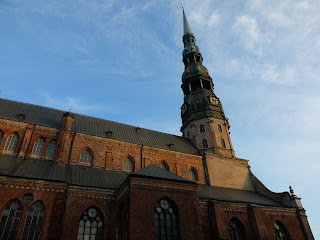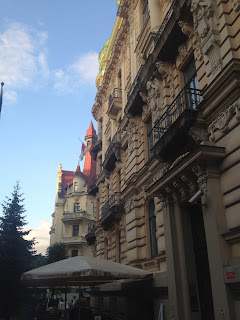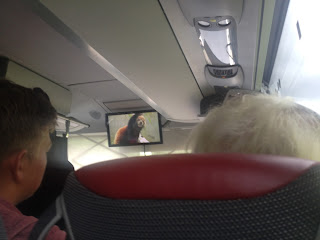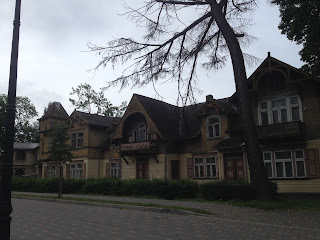Kā sauc, tā atskan.
(Just as one calls into the forest, so it echoes back.)
--Latvian idiom
Riga is a beautiful city, and I'll get back to talking about it soon as it's where I spent the majority (but not all) of my time in Latvia. But first, I want to talk about Sigulda, where Ingrid and I spent the first full day of the Latvian leg of my Baltic trip. Because it is a fantastic day trip outside of Riga, and anyone who comes to visit should absolutely take the hour-long train trip out to hike around in the forests for a day.
In part, because this is what the culture of Latvia is all about. Gettin' out into the forest, hunting for mushrooms (although I'm not foolhardy enough to give that a whirl without the supervision of someone who knows, oh I don't know let's say, anything, about mushrooms). Listening to the birds and the cicadas deliver their orchestral summertime hymn.
And in part, because it's just a beautiful, peaceful place.
The train ride to get there isn't too shabby either.
The bright orange train station of Sigulda greets you when you arrive!
Out front of the station, there are some helpful shops/tourist centers plus one very funky clock. You do you, Latvia.
Ingrid and I got a little mixed up while trying to make our way towards the walking trails of Gauja National Park, where our destination (the Turaida Museum Reserve) was located. We passed this lovely pond and the waterside Evangelical Lutheran Church.
The view, once we got to the forest's edge. Sadly the cable cars were not working although hopefully that illustrates what a steep descent down into the valley we had. In the distance you can see the silverish building which is now, apparently, KRIMULDA hotel. We would stop there to eat lunch a couple after making our way down the wood staircases down into the valley and back up the other side.
Turaida Castle in the distance.
The going was actually not bad on this part of the trail, as the steps were well-spaced and the handrail was helpful for the steeper parts. Plus, you know, downhill.
The Latvian was not extremely helpful, but the map was!
Okay, ascending back out of the valley towards Krimulda park and castle remains, we're now closer and on the same side as Turaida!
The remains of Krimulda Castle, a 14th century building made from local boulders by the Livonian Order.
DEFINITELY thought this was also a palace as we were approaching it. It may have been at one point, it's hard to tell from information online, but now it is a hotel.
Strange horseshoe-shaped building meant for summertime visitors' lounging.
A proper Latvian lunch (maybe, I don't know. It was delicious though, and sustained me for the climb back down into the valley and then back up again, later).
Next, we made our way down to Gutman's Cave (also known as Gutmanis Cave or in Latvian, Gūtmaņa ala). I actually thought this was one of the more interesting stops on our hike, so here are some fun facts (from this Wikipedia article):
- widest and highest cave in the Baltic countries
- oldest tourist attraction in Latvia
- the walls of the cave have inscriptions (cough cough graffiti) dating back to the 17th century
- Gut mann in German means "good man"
- place of ancient worship, until the 19th century, people would come to make their offerings to the deities
- source of the Rose of Turaida legend, just your classic boy-meets-girl-they-get-engaged-then-an-evil-Polish-soldier-tries-to-trick-and-rape-her-so-she-tricks-him-instead-into-MURDERING-HER-because-y'know-her-honor
For scale:
You're gonna get some hop-ons.
When one is carving one's words into the side of a cave, is this really the time to attempt a first draft of your damn life story? It is not, I would argue. This German guy had no chill.
Okay, so, I was definitely held rapt by the hundreds of year worth of vandalism for a while, but eventually it was time to continue on, towards Turaida Castle. Some scenery along the way, as we climbed back up the hill towards the hilltop settlement:
And then we entered the large museum reserve! It's not just a castle, either. First we encountered the Turaida Church, built in 1750.
Fun fact: I believe somebody told me at some point that Turaida is Livonian for "Thor's garden". There is no forgetting, in the Baltic states, just how complexly their history is tangled with their neighbors and with the surrounding Baltic countries.
Next we snuck in to take a peek in this three-room museum just as it was closing, it had a ton of cool artifacts from the Gauja Livs.
Weapons!
Looms!
Jewelry!
Then it was on to the main event, the castle. Building on this sucker started in 1240 and continued as weapons/construction technology changed throughout the intervening centuries. The wooden sections of it were burned down in 1776 and not restored until the 20th century, when Baltic German historians began to take interest in it. I think a lot of it has been rebuilt/restored at this point.
Ingrid for scale! (She's the one wearing the practical white hat. I was unhatted which was fine for the forested parts of our hike but somewhat grueling when we were out in the hot hot sun). As we were approaching this, I distinctly remember telling Ingrid that she could climb up to the top if she wanted but that I had done enough climbing for the day and would not be joining her. But then there was a sign on the door that advertised a jewelry shop on one of the many levels of the tower (there were several rounds of spiral staircase which climbed up into wooden floors inside). On each floor we were greeted with empty, high-ceilinged chambers that occasionally housed a fireplace or chandelier, but no shops. By the time we'd got to the top, I knew the jewelry had been a lie, but at least it got me to the view that can be seen in the first picture of this post.
The vista:
After climbing back down, we explored the museum grounds a bit more before hustling back to the bus stop, where we caught a bus to the train station and made a late afternoon train back into Riga.
In conclusion, if you go to Riga, especially in the summertime, take a day and go out to Gauja valley/Sigulda. See some castles. Breathe in the forest air. Eat some greasy sausages and french fries and sauerkraut for lunch, because if the cable car is broken and you've been traipsing up and down the sides of the Gauja valley all day chances are you've earned it.
Okay, now! Back to Riga. These photos are kind of combined from our first evening in Riga, our evening after we returned from Gauja/Sigulda, and the free walking tour we did on the morning before Ingrid left to return to Tallinn.
One of our first missions in Riga, after arriving on the bus from Tallinn, was to get some grub. Folkklubs had been recommended to us by a Latvian-American couple we met on Saaremaa Island, both because of the good traditional Latvian food and because of its beer selection. We were not disappointed on either front!
Atmosphere. It's like an underground cave, which is perfect for that thing where you're going to eat heavy traditional Baltic food but also it's the middle of the summer.
The bartender insisted we have some Riga Black Balsam liqueur after we'd finished our meals and really, who were we to argue? I liked this so much I ended up hauling back a couple bottles of it for Christmas presents.
This was the view from a tea house we passed on our first morning that had these great, like, bed-sized benches around the perimeter of their circle-shaped building, right next to the Pilsētas canal. We returned the next morning, the place is called Apsara Tea House and I highly recommend it both for the excellent tea and lovely, serene setting but also because they were incredibly kind and let me charge my camera batteries in one of their behind-the-counter outlets while Ingrid and I were lounging. Nice people.
Okay, so. Sights of Riga! These are from different days so I have no real narrative for them, except that in some photos you may see a blonde dude who kind of looks like a young Leonardo DeCaprio; he was our guide when we took the free walking tour.
House of the Blackheads (tee hee that name though):
An alley.
St. Peter's Church, medieval and Lutheran.
Dome Square, where Dome Church aka Riga Cathedral is located. (sunny late afternoon photos from day one, cloudy pictures from the walking tour)
Just a decorative old-school firetruck, plus some idea of how many people were out and about in the square when the weather was nice and one of several interesting murals we saw around the Old Town.
Yet another church.
This statue actually has kind of an interesting backstory. It's a depiction of the Town Musicians of Bremen, which I feel is one of the rare original German fairy tales which actually has a happy ending. Anyway, Bremen is a sister city to Riga and also they were connected during the Hanseatic era, so the statue depicting the German tale makes sense here. But this one has kind of a twist, because the animal characters can be seen breaking through a wall. It's almost like... an iron wall. Like a curtain. It's the Iron Curtain. It was gifted to the city of Riga from the city of Bremen in 1990.
Former house of Richard Wagner, who is infamous in Riga for staying two years, accumulating a mountain of debt and scandal, then peacing out.
The Cat House. You can click on the link for the "legend" if you are so inclined, as I think this post is probably dragging on long enough. It is... eh, mildly interesting, I guess!
This commemorative mosaic, set in the street tiles of a busy pedestrian square, confounded me with its contradictory messages. Should it be "the first film screenings"? I guess then it would make sense. As it is, I am incensed by the inaccuracy of what it's claiming.
The Three Brothers, the oldest domiciles in Riga (15th-17th century).
The Freedom Monument of Latvia, built to honor soldiers from the Latvian War of Independence (1918-1920) but then reinterpreted by the Soviet Union so that each Latvian symbol on the statue somehow was honoring some value/figure from Soviet history. I don't remember all the details of how they tried to alter the meaning of every part of the statue (one example I remember: the three stars the woman is holding, I think, became the "three Baltic states", instead of three districts of Latvia, which was their original meaning).
Remembering the Singing Revolution:
Passing through a nearby park, catching sight of the gilded domes of the Nativity Cathedral.
Some snippets from the Art Nouveau architecture...
(Side note: this was around the point where my camera batteries died and I realized that I'd forgotten to bring along my charger. I managed to find one in a small electronics shop on my last day in Riga, and it charged my batteries ONE time, which was long enough to capture the abandoned fortresses of Liepāja thankfully, but before that and afterwards it will sadly just be cell phone photography from here on out.)
Brace yourself for some very excellent, not at all wonky or tilted, panoramas:
The Art Academy of Latvia, not particularly notable except when we walked past it I turned to Ingrid and said, "Is that a giant disco Venus of Willendorf?" thinking that perhaps I was have a stroke. As it turns out, I was not.
One of our last adventures together, Ingrid and I headed over to these series of massive hangars that used to house German zeppelins and now are home to the sprawling Riga Central Market. It's a good last stop as there is just about every smelly food imaginable that you can purchase right before you jump onto your bus (the bus station is located directly in front of it) so as to properly torture your fellow passengers.
Approaching the market:
Between the hangars.
Entering the labyrinth.
So much food, so many people. An interesting blend of tourists trying to document the madness and locals trying to gather the ingredients for dinner. Truly a unique setting because of the hangars, and how they've kind of been divided by items (one is predominantly filled with fishmongers, another butchers, another devoted to dairy products, etc.)
All too soon it was time to see Ingrid onto her bus back to Tallinn. It was lovely being able to visit her and travel together for a while and I definitely appreciated the company, especially on our long hike in Gauja Park where I might have turned back if I'd been alone!
To ease the sudden loneliness of traveling solo once more, that evening I headed to the cinema in town and took in a delightfully fluff superhero film... Zirnekļcilvēks. It was so much fun! I really enjoyed it, and the Latvian movie-going experience. Very civil, cheap ticket prices, and an interesting array of snack choices.
Pea-flavored popcorn, for example.
Or banana, perhaps?
I settled for some Reese's which THEY ACTUALLY SELL ALL OVER THE PLACE IN THE BALTICS BUT NOT IN HUNGARY, WHHHHHHYYY?!?!?!
Anyway it was great, 10/10 both the movie and the theater.
The next day it was time to get on the road again, I had an early-morning bus to catch out to the coast, to the town of Liepaja! (fun fact: the town is nicknamed "the city where the wind is born") The bus had a TV and they were playing some documentary and in that there was a red panda playing and what else do you really need in life? I watched the landscape roll by, I listened to my music, I daydreamed about a life of mysticism and toil deep within the trees of medieval Latvia. All was well.
The town itself is very nice, with a cool old tram that creaks along from the bus/train station to the town center and wooden houses lining the winding streets; it reminded me a lot of childhood visits down to Cape May, but that was not the reason I chose this particular seaside haunt. I was there to see the abandoned, crumbling Northern Forts.
This, for me, was honestly one of the coolest stops I made in Latvia and I am hard-pressed to tell you why. The decrepit bunkers, first built in the late 1800's-early 1900's by the Tsarist Russian troops, are a far cry from beautiful. The sand and the sea and the weeds are slowly but inexorably reclaiming the land where they once stood proudly and so they are varying levels of dangerous for climbing and exploring. The spiders and the mosquitoes and other swarming, buzzing insects are plentiful.
And yet, the utter waste of it, the complete abandonment of so ambitious a vision, was somehow haunting. Perhaps for what it represented, perhaps for the scope of its failure. Perhaps I just needed to see something broken and shattered to make myself feel something, anything.
In any case, I stayed here far longer than I'd intended. It's not actually in Liepaja, it's in the village to the north (Karosta) and I had to take two buses to get there (because the driver did not stop for me when we were going northbound despite my insistent thumb driven into the call button, so I had to get out of the bus at the northernmost stop and wait for him to turn it around then pay another fare to go the three stops south, nice guy huh?).
You walk in on a lonely gravel road from the "street" (that's a generous name for it), surrounded by forest and insects, until you start seeing peeks of the now graffiti-adorned tunnels that lead towards the forts.
Finally, I reached the forts and the sea. And this perfectly situated Lada greeted me, seemed to say, "Hey! Is this not a perfect photograph or what?"
It kind of was.
People for scale.
When I finally snapped out of the daze that this place put me in, I stumbled along the gravel lane back to the main road. Buried deep in the overgrown weeds of the nearest bus stop was a schedule, and with some dismay I realized that I'd just missed the southward, Liepaja-bound bus, and that the next wouldn't come around for several hours. Desperately I considered walking along the beach until I reached the town where all my bags sat inside my AirBnb. I thought about walking back along the so-called "main road". I thought about curling up on the iron bench, letting the mosquitoes win and giving in to the late afternoon sopor that was overtaking me.
Instead I did what all desperate travelers: I stuck my thumb out. Quite a few cars whizzed by without even slowing but finally, after about maybe thirty minutes had passed, a minivan pulled over about thirty feet down the road fromm where I stood. The driver was a man named Alex. He spoke Latvian, and Russian, and a bit of English. I spoke only one of those, and I was so tired and sweaty that I would hardly even count my half of the conversation as a passable demonstration of the language. He was a taciturn fellow anyway, but he told me he was a fisherman and he dropped me off at a bus stop in Karosta where several lines passed through on their way back to Liepaja, and that was the grand sum of our interaction. I thanked him profusely in Russian and English as I climbed out of his car and he offered a gruff laugh and a wave before speeding off. Wherever you are, thanks Alex.
This cat slinked over to the stop while I was waiting and sat there, eyeballing me and seemingly waiting for me to take its picture because once I had it wandered off.
Seen in the shop: a product with my name on it! Fun plot twist: it's lard.
The weather truly began to sock in by the time I made it back to Liepaja so I picked up some VERY basic dinner ingredients and scurried back to my AirBnb. Cheese and crackers and beer, dinner of lazy champions.
Hilariously untenable bathroom situation.
Some of the buildings of Liepaja:
And that's it. The next morning I was up and out bright and early, on my way further south to the port city of Klaipėda, Lithuania!
But, before I end this post on Latvija and its many wonders, one more photo from the abandoned Northern Forts of Karosta, because I saved my favorite for last and because this sight, the sounds and the smells of this moment, still linger in my senses to this day. I kind of hope they always do.









































































































































No comments:
Post a Comment